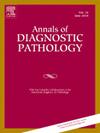Histomorphology and utility of CK17, p53 dual stain with CK 13 in the diagnosis of differentiated vulvar intraepithelial neoplasia
IF 1.4
4区 医学
Q3 PATHOLOGY
引用次数: 0
Abstract
Differentiated vulvar intraepithelial neoplasia (dVIN) is a known precursor for HPV-independent vulvar squamous cell carcinoma (VSCC). Diagnosis of dVIN can be challenging, and immunohistochemistry (IHC) may be a useful aid in this setting. A mutated pattern of p53 staining is associated with dVIN. This retrospective study evaluated the histological features and immunohistochemical utility of p53/Cytokeratin 17 (CK17) dual staining and cytokeratin 13 (CK13) staining in dVINs. At our institution, the diagnosis of dVIN is primarily based on morphology, and p53 stain is not routinely performed, especially in cases with concurrent invasive carcinoma or in recurrences. Thirty-two cases of dVIN identified from the pathology archives included 21 cases with p53 mutations and 11 cases without p53 mutations. Fourteen cases were biopsies. The staining patterns of CK17 and CK13 were compared in p53-mutated and non-mutated dVINs. p53/CK17 dual stain was used, which helped assess aberrant CK17 staining patterns adjacent to the mutated p53 patterns. Of the p53-mutated dVINs, 18/21(85.7 %) cases showed full-thickness CK17 staining. Of the remaining 11 cases with p53 wild-type staining, 5 cases showed full-thickness CK17 staining (45 %). Of the p53-mutated dVIN cases, 8/21 (38.09 %) showed full-thickness CK13 staining. Only 2/21 (9.5 %) showed loss of CK13 staining, as seen in oral dysplasia. Amongst dVINs with wild-type p53 staining, 50 % showed full-thickness CK13 staining. None of the lichen sclerosus cases showed full-thickness staining for CK13. The utility of CK13 staining in dVIN has been studied in only one previous study. A Panel consisting of p53, CK13, and CK17 antibodies may aid in increasing the accuracy of dVIN diagnosis, especially when a full-thickness staining pattern of CK13 and CK17 is noted. Further investigation of dVINs with full-thickness CK13 staining in a larger cohort is needed to confirm the results.
CK17、p53双染色与ck13在分化型外阴上皮内瘤变诊断中的组织形态学及应用
分化外阴上皮内瘤变(dVIN)是已知的不依赖hpv的外阴鳞状细胞癌(VSCC)的前兆。dVIN的诊断可能具有挑战性,免疫组织化学(IHC)在这种情况下可能是有用的帮助。p53染色的突变模式与dVIN有关。本回顾性研究评估了p53/细胞角蛋白17 (CK17)双染色和细胞角蛋白13 (CK13)染色在dVINs中的组织学特征和免疫组织化学应用。在我们的机构,dVIN的诊断主要基于形态学,p53染色并不是常规的,特别是在合并浸润性癌或复发的情况下。32例dVIN病理资料中有p53突变21例,无p53突变11例。活检14例。比较p53突变和非突变dVINs中CK17和CK13的染色模式。使用p53/CK17双染色,这有助于评估与突变p53模式相邻的异常CK17染色模式。在p53突变的dVINs中,18/21(85.7%)的病例显示全层CK17染色。其余11例p53野生型染色中,5例显示全层CK17染色(45%)。在p53突变的dVIN病例中,8/21(38.09%)显示全层CK13染色。只有2/21(9.5%)的患者显示CK13染色缺失,如口腔发育不良。在野生型p53染色的dvin中,50%显示全层CK13染色。所有硬化地衣病例均未见CK13全层染色。CK13染色在dVIN中的应用仅在一项先前的研究中被研究过。由p53, CK13和CK17抗体组成的小组可能有助于提高dVIN诊断的准确性,特别是当注意到CK13和CK17的全层染色模式时。需要在更大的队列中进一步研究全层CK13染色的dvin来证实结果。
本文章由计算机程序翻译,如有差异,请以英文原文为准。
求助全文
约1分钟内获得全文
求助全文
来源期刊
CiteScore
3.90
自引率
5.00%
发文量
149
审稿时长
26 days
期刊介绍:
A peer-reviewed journal devoted to the publication of articles dealing with traditional morphologic studies using standard diagnostic techniques and stressing clinicopathological correlations and scientific observation of relevance to the daily practice of pathology. Special features include pathologic-radiologic correlations and pathologic-cytologic correlations.

 求助内容:
求助内容: 应助结果提醒方式:
应助结果提醒方式:


